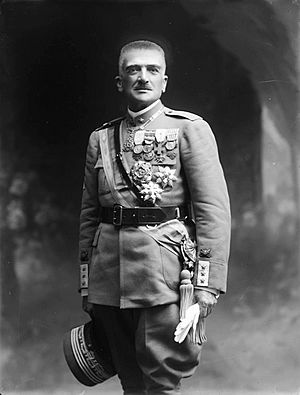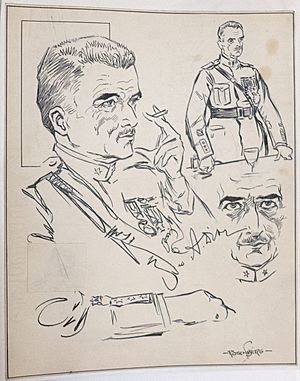Armando Diaz facts for kids
Quick facts for kids
Marshal of Italy
Armando Diaz
OSSA OSML OMS OCI
|
|
|---|---|
 |
|
| Chief of Staff of the Italian Army | |
| In office 9 November 1917 – 13 August 1919 |
|
| Preceded by | Luigi Cadorna |
| Succeeded by | Pietro Badoglio |
| Minister of War | |
| In office 30 October 1922 – 30 April 1924 |
|
| Prime Minister | Benito Mussolini |
| Preceded by | Marcello Soleri |
| Succeeded by | Antonino Di Giorgio |
| Personal details | |
| Born | 5 December 1861 Naples, Kingdom of Italy |
| Died | 28 February 1928 (aged 66) Rome, Kingdom of Italy |
| Spouse |
Sarah De Rosa-Mirabelli
(m. 1895; died 1928) |
| Profession | Military officer |
| Awards | see below |
| Military service | |
| Allegiance | |
| Branch/service | |
| Years of service | 1884–1924 |
| Rank | Marshal of Italy General |
| Unit | 49th Division of XXIII Corps |
| Battles/wars | Italo-Turkish War
|
Armando Diaz (born December 5, 1861 – died February 28, 1928) was an important Italian general and a Marshal of Italy. He is best known for leading the Italian Royal Army during World War I. He became the army's Chief of Staff in November 1917.
Diaz helped stop the Austro-Hungarian army from advancing. He led Italian forces to big victories at the Battle of the Piave River and the Battle of Vittorio Veneto. These wins were very important for Italy in the war. Many people see him as one of the greatest generals of that time.
Contents
Early Life and Military Start
Armando Diaz was born in Naples, Italy. His father was a navy officer. Diaz began his military training at the Military College of Naples. Later, he went to the Military College of Turin. He became an artillery officer in 1884.
People described Diaz as a calm and disciplined soldier. He expected the same high standards from himself as he did from others.
Before World War I
Diaz started his career in the 10th Field Artillery Regiment. He became a captain in 1890. In 1894, he attended the School of War and was the top student. He then worked in the Army Staff for two years.
By 1899, he was a major. He commanded a battalion of the 26th Infantry Regiment. In 1905, he became a lieutenant colonel. He served as Chief of Staff in Florence's Military Division.
In 1910, as a colonel, he fought in the Italo-Turkish War. He commanded the 21st Infantry. He was injured during a battle in Zanzur in 1912.
World War I Hero
When World War I began, Diaz joined the high command. He was in charge of operations under General Luigi Cadorna. In June 1916, he became a two-star general. He then commanded the 49th division and later the 23rd army corps.
In October 1917, the Italian army suffered a huge defeat at the Battle of Caporetto. On November 8, 1917, Diaz was chosen to replace General Cadorna as chief of general staff. He quickly reorganized the army. He set up defenses on the Monte Grappa mountains and along the Piave River. This stopped the Austro-Hungarian attack in the First Battle of Monte Grappa.
In the summer of 1918, he led the Italian army to victory in the Battle of the Piave River. Later that year, he commanded 1.4 million Italian troops in the Battle of Vittorio Veneto. This battle ended the war on the Italian front. Diaz announced the victory with his famous Bollettino della Vittoria (Victory Address).
After the War
After the war, Armando Diaz became a senator. In 1921, King Victor Emmanuel III honored him. He was given the title of 1st Duca della Vittoria ("Duke of the Victory").
Benito Mussolini later made him the Minister of War. In 1924, when he retired, he received the highest military honor: Marshal of Italy.
In 1921, Diaz visited Kansas City, Missouri in the United States. He attended a ceremony for the Liberty Memorial. This memorial was built to honor those who served in World War I. He was there with other famous generals and admirals from different countries. A street in Lakeview, New Orleans was also named after him.
Armando Diaz passed away in Rome in 1928. He was buried in the church of Santa Maria degli Angeli e dei Martiri.
Honours and Awards
Armando Diaz received many honors for his service:
- Knight of the Supreme Order of the Most Holy Annunciation (1919)
- Knight Grand Cross with Grand Cordon of the Order of Saints Maurice and Lazarus
- Knight Grand Cross of the Military Order of Savoy
- Silver Medal of Military Valor
- War Merit Cross, twice
- Commemorative Medal for the Italo-Turkish War
- Commemorative Medal for the Italo-Austrian War 1915-18 (4 years of campaign)
- Commemorative Medal for the Unification of Italy
- Commemorative Medal for the Italian Victory
- Bailiff Grand Cross of Honour and Devotion of the Sovereign Military Order of Malta
- Médaille militaire (France)
- Distinguished Service Medal (United States)
- Croix de guerre 1914–1918 (France)
- Croix de guerre 1914–1918 (Belgium)
- Commanders Cross of the Order of Virtuti Militari (Poland)
- He received honorary degrees from Brown University and Providence College in 1921.
See Also
 In Spanish: Armando Diaz para niños
In Spanish: Armando Diaz para niños
- Italian cruiser Armando Diaz


